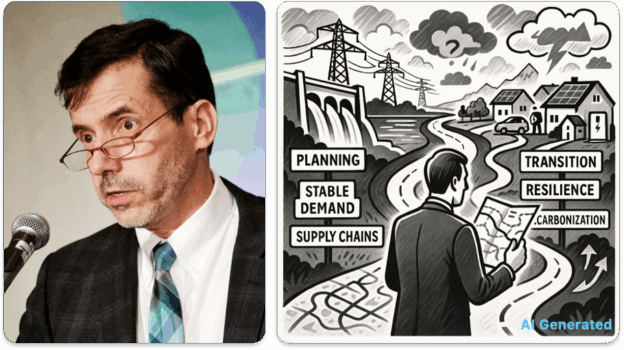Energy transition, geopolitical tensions, regulatory instability, and the weakening of Bretton Woods era institutions: power utilities now operate in a world where uncertainty is a permanent condition. It is no longer background noise to be filtered out, but a defining feature of the system.
A Break with the Historical Foundations of Planning
Electric utilities are essential and regulated services. Some are privately owned and pursue profitability, which can lead to strategic tensions when those objectives clash with long-term or public interest considerations. Others, notably in Canada, are publicly owned and may be tasked with advancing social, industrial, or regional development priorities, or even political goals. This complexity makes strategy definition more demanding, requiring a balance between operational performance, social acceptability, and alignment with sometimes evolving mandates.
For decades, North American electric utilities operated under stable conditions: moderate and predictable demand growth, centralized generation, steady supply chains, and long-term regulatory visibility. That framework no longer holds.
Today, utilities must respond simultaneously to:
- a rapid increase in demand after years of stagnation, driven by electrification and climate targets,
- the emergence of new generation technologies (solar, wind, batteries, V2G), often distributed and with low marginal costs, but requiring radically different models of coordination and planning,
- strained supply chains, especially for critical electric equipment (transformers, cables, electrical steel),
- more demanding and strategic customers, sometimes self-generators, increasingly dependent on reliable and continuous electricity service,
- and the need to recognize technological, political, or climate disruptions early enough to adapt in time.
A Regulatory Framework Often Ill-Suited
This turning point is all the more difficult because utilities, especially in North America, operate in low-competition regulatory environments focused on a rate of return on a regulatory asset base. This model rewards large, visible, capital-intensive projects but discourages agility, strategic actions, and innovation.
This challenge is compounded by internal rigidity, often due to strong union structures, which can slow the adoption of new technologies, roles, or organizational forms.
The industry structure itself also plays a role. In North America, vertical integration is still the norm: generation, transmission, distribution, and retail services are often housed within a conglomerate. This structure limits new entrants and reduces competitive pressure, slowing innovation and strategic adaptation. In contrast, European markets have introduced legal or functional unbundling of activities, along with greater market openness. This has enabled the emergence of more dynamic models. Some companies have become particularly aggressive, investing abroad or diversifying their activities. For instance, EDF has expanded internationally, especially in renewables; Enel has deployed smart grids and digital platforms far beyond Italy; and National Grid, operating in both the UK and the US, has actively pursued grid modernization and decarbonization.
Strategic Optionality as a Response
In this uncertain context, marked by deep transformations and structural tensions, the strategy must be redefined not as a fixed plan, but as a capacity to navigate uncertainty. This is especially relevant, since utilities’ objectives often go beyond profit maximization. Whether public or private, they must sometimes reconcile social, territorial, or political expectations, which makes their trajectory more complex. Optionality offers a useful framework to balance these multiple imperatives while remaining able to adapt quickly to external shifts. It involves exploring plausible futures, assessing one’s position in each, preserving room to maneuver, and investing in adaptability.
This approach entails:
- using scenario-based thinking rather than relying on single-point forecasts,
- supporting experimentation, pilot projects, and modular solutions,
- strengthening organizational resilience through talent, operational know-how, and system flexibility,
- and relocating or diversifying supply chains to reduce structural vulnerabilities.
Field Experience
In my work in strategy, planning, and economic analysis for power utilities and public institutions, I’ve seen a consistent truth: resilience in an uncertain world does not come from rigidity, but from preparing for multiple futures, learning quickly, and adjusting priorities in real time. This approach also proved essential in other sectors I’ve worked with, especially during technology transitions in telecom and IT, where managing uncertainty and disruption often made the difference between inevitable decline and meaningful transformation. “Be directionally right, not accurately wrong,” as John Maynard Keynes once said.
Long-term strategic relevance will depend less on being precisely predictive than on maintaining vigilance, mobilizing talent, and acting with flexibility. For regulated monopolies in transmission and distribution, survival is not at stake. Like cable and telephone operators, these companies will continue to exist. The challenge is to remain useful, legitimate, and able to play a structuring role in a fast-changing environment.
Acting Despite Uncertainty
It might be tempting to wait for uncertainty to pass, for clearer signals, stable frameworks, or mature markets. But that would be a strategic mistake.
Utilities no longer have the luxury of inaction. Demand is growing rapidly. Technologies are evolving. Supply chains are tightening. Customers are becoming mission-critical, sometimes self-generating. And shocks—climatic, technological, geopolitical—are multiplying.
In this context, strategy is no longer about prediction but preparation. It’s not about planning everything, but being ready to move quickly. This requires rethinking how utilities plan, invest, recruit, innovate, and engage with regulators.
Recognizing uncertainty should not paralyze action. Quite the opposite: it is a call for more lucid, agile, and accountable leadership. This is where the credibility of the sector’s leaders will now be tested.
